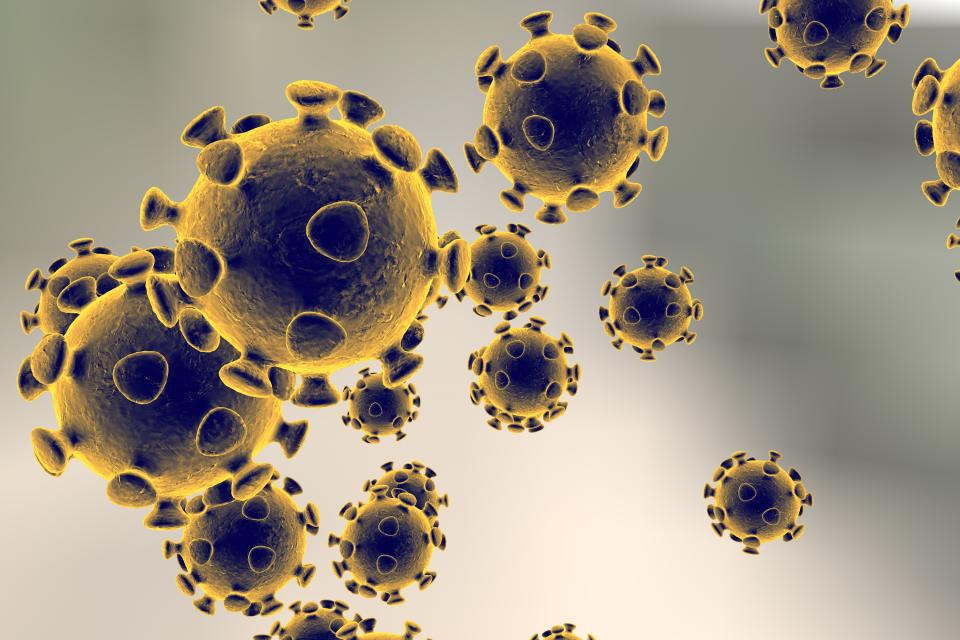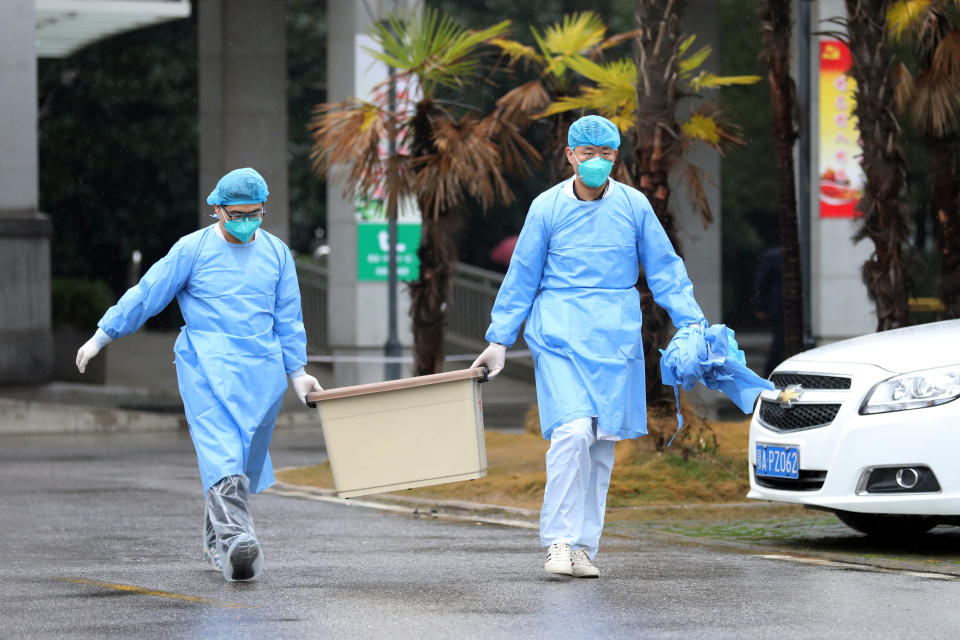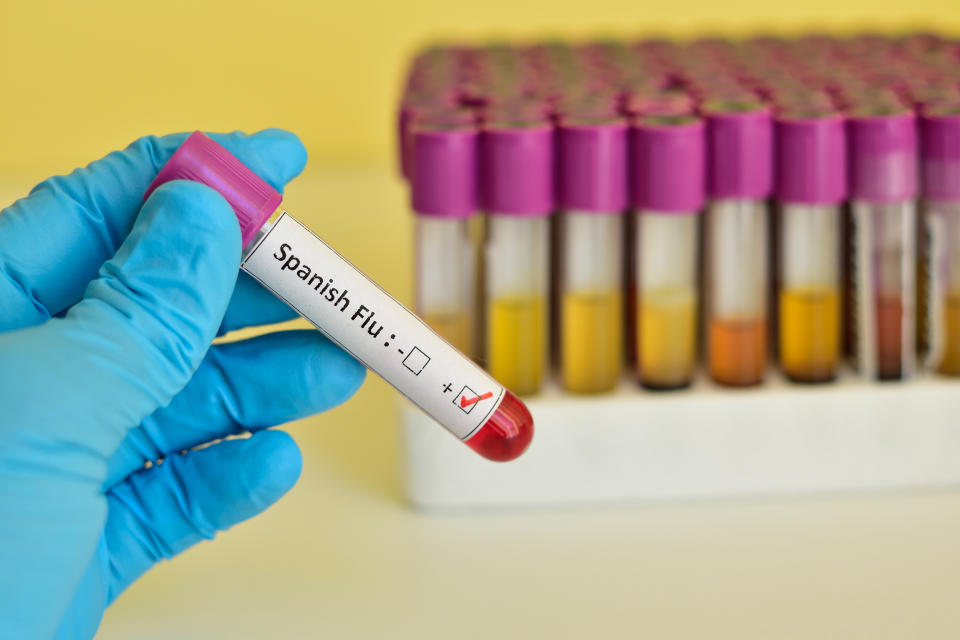China's coronavirus could have same death rate as Spanish flu outbreak in the UK
![Concern in China as coronavirus death toll rises [Photo: Getty]](https://s.yimg.com/ny/api/res/1.2/e0VjR6uzTn7pu5NFS3fmgA--/YXBwaWQ9aGlnaGxhbmRlcjt3PTEyNDI7aD04Nzg-/https://media-mbst-pub-ue1.s3.amazonaws.com/creatr-uploaded-images/2020-01/a775b200-3d39-11ea-b19f-279cf67449d7)
Editor’s note: This article was updated on January 24 to include context that the potential 1-2% death rate of the coronavirus would be comparable to the death rate of Spanish flu in the UK specifically, rather than globally where the death rate is thought to have been higher
China’s deadly coronavirus may have the same death rate as Spanish flu, an expert has warned.
While this is the early stages of the disease, deaths from the new virus rose to 17 on Wednesday with hundreds of cases now confirmed, increasing fears of widespread contagion.
The previously unknown flu-like coronavirus strain is believed to have emerged from an animal market in central Wuhan city, with cases now detected as far away as the US.
Professor Neil Ferguson, from Imperial College London, said the current rate of disease could be comparable to the death rate of Spanish flu.
The Spanish flu pandemic of 1918 is widely regarded as “the deadliest in history”, and is believed to have infected around 500 million people worldwide, killing between 20 and 50 million.
In the UK, it is thought around 228,000 thousand people died of Spanish flu from around 10 million people who were thought to have been infected - a death rate of around 2%.

READ MORE: What is the mystery illness affecting China?
Chinese officials have confirmed 440 cases of the new coronavirus strain - 2019-nCoV - so far, with 17 deaths.
Based on existing data, the disease is said to have a 2% death rate. This means that for every 50 people who catch the infection, one will statistically die.
To put this into context, around one in every 1,000 who develop flu die, giving it a death rate of 0.1%.
Death rate is different from the death toll. For example, if 100 people caught the infection and the death rate was 2%, the death toll would be two. Whereas if 1,000 people became ill, 20 would die. The total number of deaths in part comes down to the fatality rate and how many people catch the virus.
“This [2019-nCoV’s death rate] could be 2%, similar to Spanish flu,” said Professor Neil Ferguson from Imperial College London.

Professor Peter Horby from the University of Oxford pointed out that fatality estimations are based on “clinical data around hospital cases”.
Of those in hospital, “15%-to-20% are severe cases”, defined as needing ventilation.
Coronaviruses as a class are common, causing everything from the common cold to epidemics like severe acute respiratory syndrome (Sars).
2019-nCoV is thought to have originated in animals before “jumping” over to humans.
“Novel viruses spread much faster because we have no immunity,” Prof Ferguson said.
READ MORE: Billions of journeys for Chinese New Year raise fears coronavirus will spread

Fatalities are occurring as a result of pneumonia, which comes about when a respiratory infection causes the alveoli (air sacs) in the lungs to become inflamed and filled with fluid or pus, according to the American Lung Association.
The lungs then struggle to draw in air, resulting in reduced oxygen in the bloodstream.
“Without treatment the end is inevitable,” said the charity Médecins Sans Frontières.
“Deaths occurs because of asphyxiation.”
The US Centers for Disease Control and Prevention (CDC) has warned there is no specific treatment for coronaviruses
If the infection triggers pneumonia, doctors work to combat the complication.
When a virus is to blame – like 2019-nCoV – pneumonia may be treated via “antiviral medication”, according to the American Lung Association.
Yet, Prof Horby argued there is “no effective anti-viral”.
“Most pneumonia is bacterial,” he said.
These infections tend to respond to antibiotics.
“With viral pneumonia, care is ‘supportive’,” Prof Horby said.
2019-nCoV is not the first coronavirus that has got people panicked.
Sars made headlines in the early 2000s after 774 people died across dozens of countries, mainly in Asia.
Genetic analyses reveal 2019-nCoV is more closely related to Sars than any other coronavirus.
“Sars was nearly universally severe,” Prof Ferguson said.
“Most cases in China are described as ‘mild’.
“We’re not sure what that means.”

What is the coronavirus 2019-nCoV?
The city of Wuhan is at the centre of the outbreak, which likely originated from infected animals at a market.
Most of those who initially fell ill worked at, or visited, the market.
China's National Health Commission confirmed the virus can spread person-to-person, with patients in major cities like Beijing and Shanghai.
Cases have also arisen in Japan, South Korea, Thailand, Taiwan and the US.
Prof Ferguson claims Wuhan likely has around 4,000 cases, Yahoo UK reported.
Like other strains of coronavirus, 2019-nCoV typically starts with flu-like symptoms, including fever, cough, shortness of breath and breathing difficulties.
Six coronaviruses are known to infect people, with this strain being the “seventh”.

READ MORE: Novavax Working On A Coronavirus Vaccine Candidate As First US Case Emerges
The pathogens trigger mild-to-moderate upper respiratory tract infections, like the common cold, according to the CDC.
In rarer cases, coronaviruses can lead to lower-respiratory tract infections, such as pneumonia or bronchitis.
These tend to occur in babies, the elderly or those with weak immune systems.
Coronaviruses commonly spread via coughing, sneezing, shaking hands or touching a contaminated object.
The virus enters the body if contaminated hands touch the eyes, nose or mouth.
In rare cases, faecal contamination is to blame.
US health officials are working on a vaccine against 2019-nCoV; however, it will likely be months before the first stage of trials are underway and more than a year before one is available to the public, CNN reported.
For now, the World Health Organization advises people avoid “unprotected” contact with live animals, thoroughly cook meat and eggs, and stay away from those with flu-like symptoms.
*The death toll was accurate at the time of publication.


